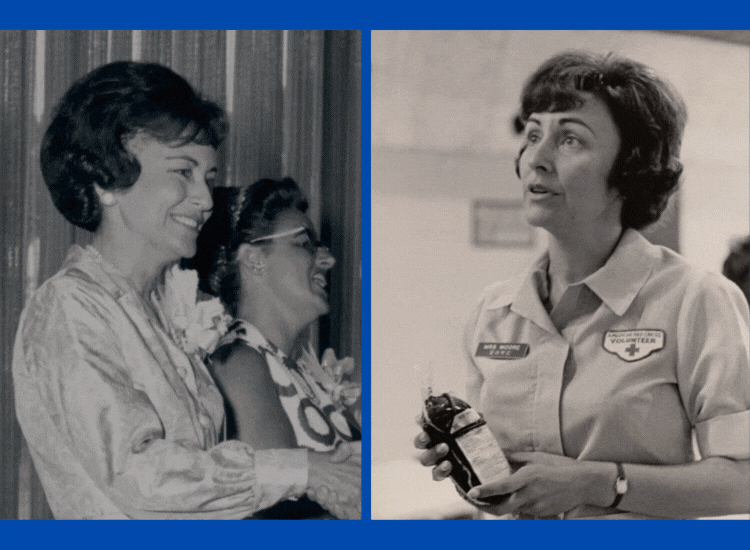Julie Compton Moore:
“One of the Finest Army Wives Who Ever Walked”
From her birth on an Army base to her burial plot on the Georgia Army base now named for she and her husband, Lt. General Harold G. Moore, Julie Compton Moore’s life was centered around the United States Army.
They married in 1949 with a military ceremony which included the traditional crossed swords. The following 32 years of his active-duty service included the birth of five children and 28 moves across 10 states and two countries. Two sons became West Point graduates like their father and followed in his footsteps as Army officers.
She was born at Fort Sill, Oklahoma, the only child of Army Colonel Louis J. Compton and Elizabeth Boon Compton. When she was 12, her father deployed to fight WWII in Europe. Her Kentucky born husband was wounded in both Korea and Vietnam and one son fought with the 82nd Airborne Division in Panama and the Gulf War.
Their life together as a “command team” is featured in three books, one movie and two museum exhibitions. In the 2002 movie based on her husband’s first book, We Were Soldiers Once… And Young, Mel Gibson portrays Hal Moore and Madeline Stowe portrays Julie Moore.
The book and movie focus on the events around the battle of Ia Drang, the first major ground engagement of the Vietnam war which included the First Battalion, Seventh Calvary under the command of Hal Moore, among many other air and ground combat units. More than 2,000 Vietnamese combatants vastly outnumbered the American forces. Following an intense three-day battle, the Vietnamese left the battle and 600 dead behind.
Back on the home front, the impact of the Ia Drang battle was deeply felt in Columbus, Georgia, where Julie lived with her five young children. Joseph Lee Galloway, who co-authored two books with General Moore – We Were Soldiers Once … and Young and We are Soldiers Still described the events of 1965 in a 2004 obituary tribute for Julie Moore written for McClatchy Newspapers. He called Julie Moore, “one of the finest Army wives who ever walked.”
“In the dark days of November 1965, she did the hardest duty of all: She visited the small bungalows and trailer houses around Columbus, Ga., to offer her sympathy and support to new widows whose husbands had died in action in the Ia Drang Valley of South Vietnam,” Galloway wrote.
“In those early days of the war the Army was overwhelmed by hundreds of death notices for unsuspecting families. It had forgotten how to do this right, so the Western Union telegrams were handed over to taxi drivers. Julie Moore was horrified when one taxi driver pulled up to the small house where she and the five young children of Lt. Col. Hal Moore, commander of the 1st Battalion 7th Cavalry in Vietnam, were living. It took her a long, long time to answer the doorbell, a lifetime really, and then the driver apologized, said he was lost and asked her where he could find this address.
“Mrs. Moore followed in the wake of that taxi and others to comfort the new widows and orphans of a war that would, itself, ultimately be orphaned and abandoned. She also raised unshirted hell with the Pentagon about so callous a method of notifying the families.”
Within two weeks the policy was changed. Even as she worked to change the policy, she attended each Columbus-area funeral. The new policy required casualty notifications by an officer and a chaplain who would personally deliver the news and convey the condolences of a grateful nation. This policy became standard throughout the military.
The shift in survivor notification was the beginning of a concern for Army families which grew into the Army’s Community Service Organization, now a fixture on all Army posts.
Fort Moore is the only military base named for a couple. Documents supporting this name change note, “Wherever her husband was stationed, Mrs. Moore became an integral part of the community, serving as a Brownie and Girl Scout Leader, Cub Scout Den Mother and Red Cross volunteer in the Army hospitals. She supported the day care centers and worked with the wive’s clubs to take better care of the enlisted soldier and his family. Mrs. Moore was especially active in setting up the Army Community Service organizations that are now a permanent fixture on all army posts and which assist each soldier as they process into their new duty stations.”
Julie Moore wrote in a 1996 letter describing her husband’s early overseas deployment:
“We had a tight knit group of wives who really tried to help each other, took over if one got sick or needed help with the children. It is really hard to describe the special closeness that Army wives have to each other. Even though I was lucky enough to end up a General’s wife, I never forgot that I started out as a lieutenant’s wife and the burdens they carried of raising young children with never enough money or husband.”
Julie and Hal Moore are buried together in the cemetery of the sprawling military complex which now bears their name – not far from her parents and amongst the men who died so long ago in Vietnam. Each of them is honored with a special permanent exhibit at the Fort Moore Infantry Museum and Hal Moore is featured in a Smithsonian Museum of American History exhibit on the Vietnam War.

